- Home
- Peter Ackroyd
J. M. W. Turner Page 3
J. M. W. Turner Read online
Page 3
At the Royal Academy exhibition in that year he confirmed his ambition, and his newly found fame, with the display of his first historical painting. History painting was, in this period, considered to be the pinnacle of artistic achievement, equivalent to epic in the field of literature. Any English artist worthy of the name had to master it. His own attempt, The Battle of the Nile, was of course concerned with contemporary history; it commemorated Nelson’s victory in Egypt the year before, but it was no doubt executed in the grand manner used for sensational naval battles. It has since been lost.
Although he would continue to exhibit historical paintings, his artistic passion and instinct lay elsewhere. That is why, when he first saw the mythological landscapes of Claude, he responded with great and uncharacteristic emotion. Claude Lorrain, the seventeenth-century artist, was justly celebrated for the clarity and harmony of his landscapes; he was also the first to include an image of the sun within his paintings, a shining talisman for Turner himself.
An art patron had asked the young Turner to see Claude’s Seaport with the Embarkation of the Queen of Sheba, and a contemporary recalled that on viewing it for the first time “Turner was awkward, agitated and burst into tears.” When he was asked the cause for this display of tender feeling, Turner replied, “Because I shall never be able to paint anything like that picture.” This mid-seventeenth-century master-work, in all its luminous serenity, seemed to the young English painter to be quite beyond his grasp. When he saw two other of Claude’s landscapes, at Beckford’s house in Grosvenor Square, he is reported as saying that they “seemed to be beyond the power of imitation.” Yet he sought for Claude’s ethereal harmonies all his life. In later years he was in fact deemed comparable to the French artist, and indeed can still survive that comparison.
He travelled to Wales and Lancashire in 1799, in search of the sublime, and on his return to London was soon informed that he had been elected an Associate of the Royal Academy. This was the preparatory step toward becoming a full Academician, and immediately he joined a dining society known as the Academy Club. It cannot be said that, at this time of his life, Turner was averse to convivial company. As a further token of his enhanced status he had moved his studio from Hand Court and Maiden Lane to the more respectable quarter of Harley Street. In his new painting-rooms he had space to express his vision; he was also still close to Sarah Danby and her increasing family. He never discussed his illegitimate children, two daughters named Evelina and Georgina, but he never disowned them. They spoke freely of their father, Turner, and he mentioned them in his will.
George Dance’s portrait of Turner. Drawn in March 1800, it marked Turner’s recent election to the Royal Academy as an Associate at the age of 24.
Soon after Turner’s removal to Harley Street his father gave up Maiden Lane and joined him. With his wife confined in an asylum the old man would have been increasingly isolated without the help and encouragement of his son. William Turner then took on the role of Turner’s general assistant, stretching and preparing canvases as well as writing letters on his son’s behalf to various clients and patrons. He may also have acted as caretaker for the new studio. Or he may have shared the house in Norton Street with his son and Sarah Danby, walking to Harley Street for the day’s work as the painter’s factotum. For the remainder of his life he loved, and shared in, his son’s success.
There is a story of Turner being invited to a grand dinner. When he hesitated in accepting, his father appeared at the door and exclaimed, “Go, Billy, go! The mutton needn’t be cooked, Billy!” It seems that William Turner worked for his son as housekeeper as well as painter’s assistant, and no doubt wanted to avoid the unnecessary expense of dinner at home. Turner was in any case now a fashionable figure who might have expected many such invitations to dine out. A sketch by George Dance, executed in this period, gives the impression of a young man who is climbing to the topmost rung of his profession.
He was described by one contemporary as an “odd little mortal,” and by another as “anything but nice looking.” He had bandy legs, and big feet. In later life he was variously compared to a sailor, a farmer and a coachman. No doubt because of his ruddy complexion, he was thought to resemble the captain of a steamboat or the pilot of a North Sea vessel. These marine similes would have met with his enthusiastic approval, however, since he always loved the sea and the things of the sea. His features were perhaps “coarse” by the standards of the day, by which was meant that he did not really resemble a gentleman. But he was not a gentleman. He was a Cockney visionary, a true London type whose fraternity could be seen on the streets of the city. Someone once said that he was as ugly as a “Guy,” that creature of the bonfire parades, and in truth with his beaked nose he did look a little like Punch. He was also said to have hands that were “not clean.” The reason is that he used his fingers to draw the paint across the canvas. There is a story of a visitor proclaiming himself to be an artist. Turner asked to see his hands and, when he looked at them, informed him that “you are not an artist.” They were too pale.
In his new studio in Harley Street Turner completed the largest canvas he had yet undertaken, The Fifth Plague of Egypt; despite its biblical subject the effects of thunder and hail were taken from a storm he had recently witnessed in Wales. This was also the setting for the second oil painting he exhibited in 1800, Dolbadern Castle. We may see this as evidence of his twin preoccupations with historical painting and with landscape, except that both paintings are filled with gloomy majesty. In the succeeding year his Dutch Boats in a Gale was described by Benjamin West, the grandest historical painter of the day, as “what Rembrandt thought of but could not do.”
The Cockney visionary in 1816. Turner looked a little like Mr. Punch, and this sketch by C. R. Leslie is doubtless a truer likeness than the romanticized self-portrait of 1799 (see colour section).
With supporters such as this it was perhaps inevitable that Turner would be elected as a full Academician in February 1802. He seems to have been so elated by his achievement, however, that he succumbed to bravado. When informed that he should thank his fellows for voting on his behalf he replied that he “would do nothing of the kind . . . Why thank a man for performing a simple duty?” He had become pre-eminent, easily the leading painter of his day, and he knew it. In the exhibition of that year he changed his name from “W. Turner, A” into “Joseph Mallord William Turner, RA.” He even became slightly pugnacious. He had an altercation with a respectable painter, Sir Francis Bourgeois, in which he suggested the older man’s “incompetency.” Bourgeois called him “a little Reptile.” Turner replied that Bourgeois was then “a great Reptile—with ill manners.”
On another occasion, shortly afterwards, he even rebuffed his old friend Farington; Farington and others had left a meeting of the Academy Council but, on their return, Turner had taken the chair “and began instantly with a very angry countenance to call us to account for having left the Council . . . I replied to him sharply and told him of the impropriety of addressing us in such a manner.” Farington added that Turner’s behaviour had already “been cause of complaint to the whole Academy.” Turner was indeed being accused by other Academicians of presumption and arrogance. But since the public prints were describing his work hanging in the 1802 exhibition as displaying “genius” and “sublimity of conception” he had some reason for selfconfidence. He was creating master-works of landscape and historical painting. He was being compared to Claude, Rembrandt and Gainsborough.
It is a sure sign of his worth that he was also being championed by the younger artists of the day. Where their elders considered him too “extreme,” too revolutionary, they believed him to be leading a necessary change in taste. He was in the forefront of the time, provoking criticism and jealousy while still moving ahead. Like many other artists of many other periods, he was accused of trying only to shock and to enrage the public. He wanted novelty for the sake of novelty. As one journal put it, “A certain artist has so much debauched th
e taste of the young artists by the empirical novelty of his style of painting that a humourous critic gave him the title of over-Turner.”
CHAPTER THREE
1802–1805
In the summer of 1802 the over-turner set off for his first journey outside England; in the middle of July, he travelled to Paris. That city did not then have the reputation for bohemian or “artistic” life that it acquired in the late nineteenth and early twentieth centuries—Italy was still considered the natural home for art and artists— and, for Turner, France was only the first stage of a journey to the mountains of Switzerland. He crossed the Channel in a packet-boat, from Dover to Calais; during a severe storm he found himself clambering into a small boat near the entrance to Calais Harbor, almost swamped by waves. But what more appropriate entry for a marine painter who loved the turbulent sea? As soon as he reached the pier he took out his sketchbook and drew the scene.
When he arrived in Paris he hired a cabriolet and set off for Switzerland. There he revelled in the valleys and the mountains. He sketched Mont Blanc and the Mer de Glace; he crossed the great St. Bernard Pass; he visited the Reichenbach Falls and the eighty-foot waterfall at Schaffhausen; he went along the St. Gothard Pass as far as the Devil’s Bridge. He was observing all the effects of the mighty and the sublime, finding amongst this stupendous scenery visions of the work he would accomplish. He told Farington later that the “fragments and precipices [were] very romantic and strikingly grand.” He made four hundred sketches during the course of this journey, working quickly on the spot to create mass and outline.
On his return to Paris he made his pilgrimage to the Louvre, where he closely studied the works of Titian and of Poussin, Raphael and Correggio. He was not in a state of permanent rapture. He was disappointed by Rembrandt and disapproved of Rubens. His brief notes of the works have survived, and demonstrate his close attention to detail. Of Titian’s The Entombment , he writes that “Mary is in blue which partakes of crimson tone, and by it unites with the bluer sky.” The emphasis here, and in other of his notes, is upon the colours employed by the artist. His is almost a technical examination of pictorial effect; he is investigating the professional skills of other artists in order to learn from them.
The results of his travels were on display in the exhibition of 1803. He portrayed his turbulent arrival in France with a seascape, Calais Pier, that was accompanied by oil-paintings set in the regions of Bonneville and Mâcon. The latter, entitled The Festival upon the Opening of the Vintage of Mâcon, was executed in Claude’s grandest manner; the setting, however, owes less to France than to the Thames by Richmond. The landscape itself is irradiated by a strong human presence, with labourers dancing or reclining; these figures reaffirm Turner’s interest in work and activity. He had a strong preoccupation with labour, and with rest after labour. He had a deep interest in the prospect of endurance through time. But these are also figures bound in communion with a specific place, as if they had grown out of the earth and belonged to it. It was one of his visionary conceptions.
There is also an oil-painting of the Holy Family, inspired by seeing Titian in the Louvre, but it failed to find a purchaser. His critics accused him of painting “blots” or “embrios,” of creating works in which the viewer had to imagine what was being shown, which suggests that they had already divined the indeterminacy and freedom of Turner’s vision. His paintings were “unfinished” and the subjects were not “made out” in any formal sense.
His independence was underlined by his decision to open a gallery of his work in the spring of 1804—just three days after the death of his mother in Bethlehem Hospital. It was not unusual for artists to have private galleries, but it was surprising for an artist not yet thirty to embark on the enterprise; it was another mark of his self-confidence. The gallery was situated on the first floor of his house in Harley Street, in an extension that covered part of the garden, and became in essence a private showroom where selected guests could wander and wonder. It was not particularly large—a plan of the site shows an “outbuilding” some sixteen feet by thirty-eight feet—but it became the home for the majority of his paintings and the primary source of his income. He referred to it as “the shop.” Indeed some of his oil-paintings were now being sold to private dealers for three or four hundred guineas.
He seems also to have been particular about less important financial matters; he used to charge his patrons and buyers for the frames. But prospective purchasers were not discouraged. He sold his work to collectors of “Old Masters,” such as Beckford himself, and also to successful fellow artists. He had no “agent” until a much later date in his career, but he was not deficient in the arts of the salesman. In any case, as one artist put it at the time, why should he not ask such prices when no one else could paint such pictures?
But the gallery was more than just a commercial enterprise. He thought of his canvases as a “family,” and he often became permanently attached to certain favoured family members. He disliked selling them, and in some cases refused to do so, and was heard to enquire, “What is the use of them but together?” In his will, he stipulated his purpose of “keeping my works together.” It is an understandable impulse, perhaps, in an artist who had a keen sense of his historical achievement no less than of his visionary purpose. He wanted his audience to understand the complete statement.
No catalogue of the first exhibition in Harley Street has survived, although a painting on panel of Old Margate Pier is a likely candidate for inclusion there. But his business at home did not prevent him from exhibiting at the Royal Academy in the same year; in fact, to get away from the noise of the builders in Harley Street, he worked upon one canvas in the Keeper’s rooms of that institution. It was entitled Boats Carrying Out Anchors and Cables to Dutch Men of War in 1665 , and it was accompanied by Narcissus and Echo. He was exhibiting his range, albeit with the twin themes of water turbulent and water limpid. There was also a further extension of that range in a startlingly different direction. Appended to the entry of Narcissus and Echo, in the exhibition catalogue, there were some verses composed by Turner himself. He had already included lines by Milton to describe earlier paintings, as a way of setting the context for a painted scene, but this seems to have been the first occasion when he wrote his own. They became something of a custom, too, and purported to come from an unfinished epic poem entitled “The Fallacies of Hope.” He never published any final or finished version of the poem, and it is entirely likely that it never existed except in his own mind. It existed, perhaps, only to provide quotations for his finished paintings.
In his poetry the emblem of chaos and destruction is the shipwreck. And in the private gallery on Harley Street, in the following year, 1805, he showed what was perhaps his most famous painting to date. The Shipwreck —or The Storm as it was originally called—displayed to John Ruskin “infinitely more power of figure painting than ever landscape painter showed before.” The great masses of water, the sweeping diagonals of sails and masts, the heaving vortex at the centre of the composition, impart to it a truly awe-ful authority. A later critic has suggested that in this work Turner “had become possessed by the true genius of oil painting.” But of course he had also become possessed by the wild sea. Although we may be given some leave to doubt the actual truth of the anecdote of Turner strapped to the mast (p. 151), which he assiduously promoted, it does emphasise the evident fact that he seems almost to identify with the elements of storm and sea. As Titus says in Shakespeare’s play, Titus Andronicus, “I am the sea.”
Mezzotint of The Shipwreck (1805), the first of Turner’s paintings to be engraved. This was an important step in Turner’s career: prints were sold for £2.2s and proofs for £4.4s.
The Shipwreck was the first of Turner’s oil-paintings to be engraved, and thus became the first in a series of works that would help to enlarge the artist’s reputation beyond the ranks of the collectors and the dealers. He would also begin to illustrate the works of poets and novelists for the purpo
ses of engraving. In his dealings with printers he was thorough, succinct and practical; he bargained with them shrewdly, and oversaw their work with a careful eye. He was a good man of business, in other words, whose professionalism touched every aspect of his life.
CHAPTER FOUR
1805–1811
After the Battle of Trafalgar, in the autumn of 1805, the body of Nelson was brought by the Victory to the mouth of the Thames. Turner was given permission to board the boat and to make sketches, drawings, and notes of the occasion. He interviewed members of the crew and carefully wrote down the details of their appearance, all in preparation for the grand canvas he was about to begin. “C. Hardy rather tall,” he jotted down, “looks dreadful . . . fair, about 36 years.”
He saw the Thames in a less haunted and funereal mood when he rented a riverside house in the village of Isleworth, not far from Richmond—a place that, in his canvases, becomes enchanted. It was a medium-sized house, double-fronted, with a summer-house at the bottom of the garden beside the water. It was called Syon Ferry House, because the ferry itself shuttled between his front door (so to speak) and the deer park at Richmond. He started a new sketchbook which he entitled “Studies for Pictures, Isleworth.” He drew scenes along the river-bank, and the boats which sailed along the river itself.
The pavilion, near Isleworth, where Turner lived in Syon Ferry House on the Thames during 1805 and ’06. The design shows an idyllic scene worthy of Claude, the painter whom Turner most admired.

 The Clerkenwell Tales
The Clerkenwell Tales The Canterbury Tales
The Canterbury Tales J. M. W. Turner
J. M. W. Turner Chatterton
Chatterton The Canterbury Tales – A Retelling
The Canterbury Tales – A Retelling Alfred Hitchcock
Alfred Hitchcock Three Brothers
Three Brothers Wilkie Collins
Wilkie Collins Venice
Venice Poe
Poe The Lambs of London
The Lambs of London London
London Queer City
Queer City Revolution, a History of England, Volume 4
Revolution, a History of England, Volume 4 Venice: Pure City
Venice: Pure City Foundation
Foundation Thames
Thames The Plato Papers
The Plato Papers The house of Doctor Dee
The house of Doctor Dee Rebellion: The History of England from James I to the Glorious Revolution
Rebellion: The History of England from James I to the Glorious Revolution Albion: The Origins of the English Imagination
Albion: The Origins of the English Imagination The Fall of Troy
The Fall of Troy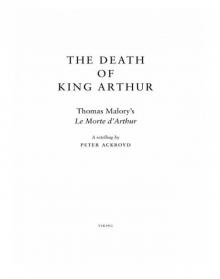 The Death of King Arthur
The Death of King Arthur The Trial of Elizabeth Cree
The Trial of Elizabeth Cree London: The Biography
London: The Biography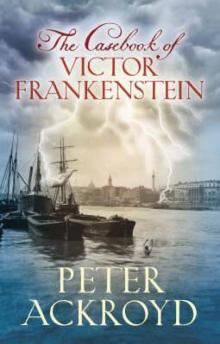 The Casebook of Victor Frankenstein
The Casebook of Victor Frankenstein Hawksmoor
Hawksmoor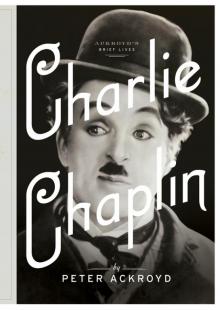 Charlie Chaplin
Charlie Chaplin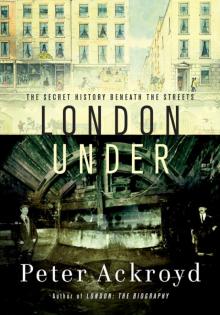 London Under
London Under